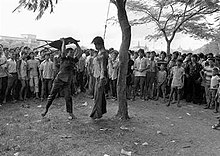
Back Massaker an der Thammasat-Universität German Masacre del 6 de octubre Spanish Massacre de l'université Thammasat French Pembantaian Universitas Thammasat ID Massacro dell'Università Thammasat Italian 血の水曜日事件 Japanese ព្រឹត្តិការណ៍ ៦ តុលា Cambodian ເຫດການ 6 ຕຸລາ Laothian Massakren på Thammasat-universitetet NN Massakren på Thammasat-universitetet NB
| 6 October 1976 massacre | |
|---|---|
 A crowd looks on, some with smiles on their faces, as a man uses a folding chair to beat the hanged body of an unknown student just outside the university. Photo by Neal Ulevich. | |
| Location | Thammasat University and Sanam Luang in Bangkok, Thailand |
| Coordinates | 13°45′21.07″N 100°29′27.16″E / 13.7558528°N 100.4908778°E |
| Date | 6 October 1976 05:30–11:30 (UTC+7) |
| Target | Students and leftist protesters |
Attack type | Crackdown and lynching |
| Deaths | Protestors: 40,[1] (Unofficial death-toll estimated by Puey Ungphakorn: 100+,[2] Ruam Katanyu Foundation: 500+ people)[3] Perpetrators: 5 |
| Injured | Official estimate: 167 |
| Perpetrators | Royal Thai Police Village Scouts Nawaphon Red Gaurs Right-wing bystanders |
| Motive | Anti-communism Right-wing extremism Ultra-royalism |
| Website | doct6 |
The 6 October 1976 massacre, also known as the 6 October event (Thai: เหตุการณ์ 6 ตุลา RTGS: het kan hok tula) in Thailand, was a violent crackdown by Thai police and lynching by right-wing paramilitaries and bystanders against leftist protesters who had occupied Bangkok's Thammasat University and the adjacent Sanam Luang, on 6 October 1976. Prior to the massacre, thousands of leftists, including students, workers and others, had been holding ongoing demonstrations against the return of exiled former Prime Minister Thanom Kittikachorn to Thailand since mid-September. Official reports state that 46 were killed (on both sides) and 167 were wounded, while unofficial reports state that more than 100 demonstrators were killed. In the "Documentation of Oct 6" project, historian Thongchai Winichakul argued that the official death toll should be 45, 40 demonstrators and 5 perpetrators since one demonstrator died in jail after the incident.[1]
In the aftermath of the events of 14 October 1973, the military dictatorship which had ruled Thailand for more than a decade was overthrown. Political, economic and ideological factors caused the society to polarize into socialist-minded left, and conservative and royalist right camps. The unstable political climate which was exacerbated by the existence of fragile coalition governments, frequent strikes and protests, and the rise of communist governments in neighboring countries led at least two factions of the armed forces to conclude that they needed to launch another coup in order to restore order; one faction plotted to bring Thanom back in order to provoke turmoil which could be used to justify a coup.
On 19 September 1976, Thanom returned to Thailand, was instantly ordained at Wat Bowonniwet Vihara, and was visited by the King and the Queen, resulting in anti-Thanom protests and demonstrations. On 5 October, the protesters were accused of lese-majeste following a mock play which led to right-wing allegations that its actor looked like the Crown Prince; the police and rightist paramilitary groups then gathered outside the university. Between 5.30–11.00 a.m. on the morning of 6 October, the police used war-grade weapons, including assault rifles, grenade launchers, anti-armor rounds and grenades, to wage the crackdown against the surrounded protesters who briefly tried to defend themselves but they were quickly defeated.[citation needed]
Some scholars have taken the position that the monarchy partly contributed to the events which unfolded by supporting Thanom's visit.[4]: 31
- ^ a b "40 Victim's Names of Oct 6". Documentation of Oct 6 (in Thai). 11 October 2018. Retrieved 24 September 2021.
- ^ Ungphakorn, Puey (July–September 1977). "Violence and the military coup in Thailand". Bulletin of Concerned Asian Scholars. 9 (3): 4–12. doi:10.1080/14672715.1977.10406422. ISSN 0007-4810. Retrieved 24 September 2021.
- ^ "คดีประวัติศาสตร์ 6 ตุลาคม 2519 : แง่มุมในหลืบประวัติศาสตร์". Archived from the original on 21 July 2020. Retrieved 23 September 2022.
- ^ Cite error: The named reference
Jileswas invoked but never defined (see the help page).